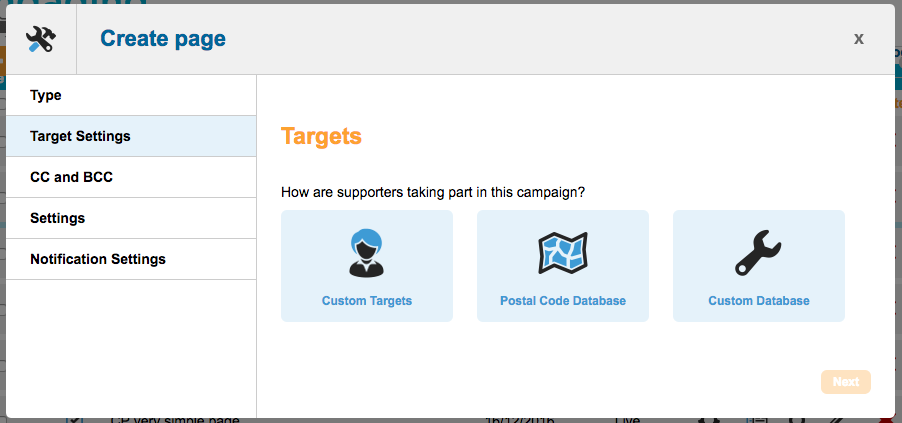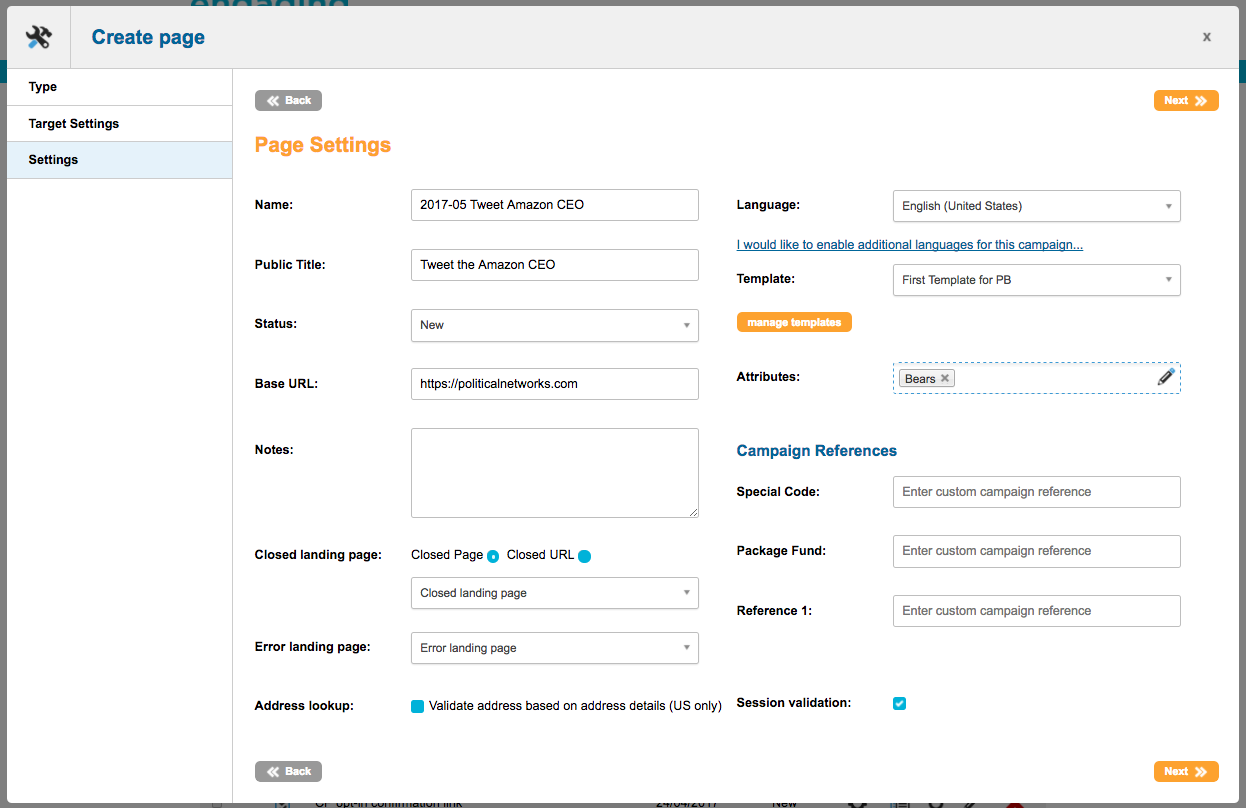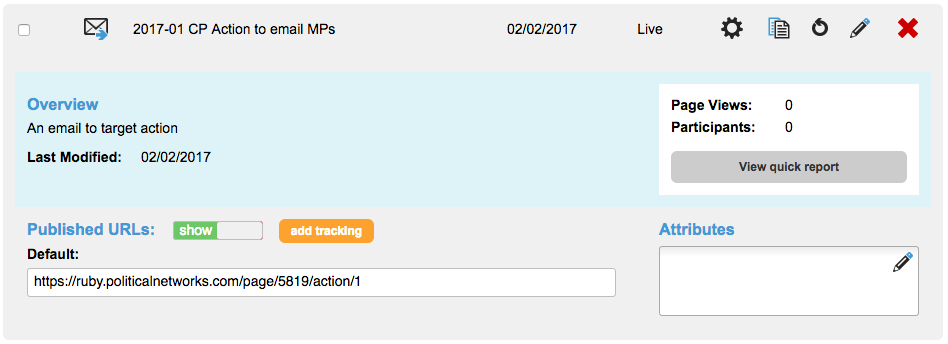You use an ‘email to target’ action when you want to get your supporters to send message(s) to politicians or campaign targets. We maintain a list of databases that you can use. Based on the postcode entered by your supporters, the relevant target(s) will be listed as recipients for them to email. Alternatively, you can also enter your own targets into the system and set them as the recipients of the action.
In each case, when your supporters send off their message, the emails the target(s) receive come ‘from’ your supporter’s email address (but obviously we generate them).
Summary of the steps
Here is a summary of the steps we’ll be going through, which you can also use as a reminder if you have created one before. Click Next at the bottom of this page to get a detailed explanation of each step.
- Create your email to target page. Create from scratch or duplicate an existing page
- Select your targets. Custom targets, Postal Code database, or Custom database
- Update your page settings. Determine what template to use
- Add the content of your page. Add text, form fields, buttons and a target block.
- Test and launch your campaign!
Create your email to target page
To create a new campaign, you can either duplicate or create a new one from scratch.
To create a brand new page, click ![]() . You will be shown a variety of different pages you can make:
. You will be shown a variety of different pages you can make:

Click on “Email to target” and click Next. You will be taken to the settings page which you can read about on the next step.
Duplicating an existing campaign instead
Alternatively you can duplicate an existing page you have previously created. To do this, go to your list of campaigns (by clicking on Pages > Manage Pages in the menu) and next to the one you wish to duplicate, click the button under the “Dup” column ![]() . It will ask you for a new name (the box may further down the screen so you might need to scroll). Enter this and click Duplicate.
. It will ask you for a new name (the box may further down the screen so you might need to scroll). Enter this and click Duplicate.
Click the settings icon ![]() in the toolbar and go to the next step.
in the toolbar and go to the next step.
Select your targets
The first step is to decide on the target, or targets, of your campaign.


You have three options:
Custom targets
This option allows you add your own targets for your action. You can choose from targets you have added previously, or create new ones. You can also select from a group of contacts, as well as contacts that cannot be emailed but have their own web form that we can connect to.
Postal Code Database
This option allows you to use one of our post code databases, such as Senators or MPs, which will select target(s) according to where the supporter lives. You can use up to two postal code databases on one page.
Custom Databases
This allows you to upload your own database for use on your campaign. Targets are selected according to a matched field within the database. For example on Page 1 you could ask who their electricity supplier is, and then on Page 2 it would look at your custom database for the supplier and return the target information such as email address so the supporter can email them. Read more.
CC and BCC
After selecting your targets, you will be shown a CC and BCC screen. This is optional, but allows you to add additional targets (or yourself) to be copied into emails sent out by your campaign. BCCing yourself can be useful if you wish to see what your supporters have written (if the message is editable) since this is not stored in the database.
Click Next to advance to the next step of creating your campaign – updating the settings.
Sender settings
We strongly recommend you add a sender envelope to help improve deliverability. Click here for more information.
Update the page settings
You can also access this screen later on via the settings icon ![]()
![]()
![]()
![]()


The following fields can be completed:
- Name: This is the reference name of your page for your own purposes (the supporter won’t see this). It is a good idea to come up with a naming convention so you can keep track of your campaigns, which is especially useful when using the query builder. For example, “2017-01 Ocean MP action”
- Public title: This field is the public name of your page. You can reveal this by using page tags.
- Status: By default, pages are “New” until you are ready to launch them. New means that the live URL is not available until you set the status to “Live”. You can also close pages here.
- Base URL: The Base URL is the first part of the address of your page (the domain). Unless you have changed the default Base URL in your account preferences, this will be engagingnetworks.app. For more about the Base URL, click here.
- Notes: Any notes you want to add, type in here. This is for internal use and isn’t visible to supporters.
- Closed landing page and Error landing page: read more here.
- Address lookup: US Only – this allows you to validate addresses using postal code mapping.
- Language: You can optionally add the ability to have different locales for your page, so that text blocks, forms and so on show different versions depending on the browser language.
- Template: The template determines how your page looks – the header and footer, as well as fonts, colours and so on. For more about templates, click here.
- Attributes: You can optionally catergorise your page according to Attributes.
Once you click next, you can optionally set notification settings which will can send you an email when a supporter completes the page. Click Save and the admin screen will close, showing you the Page Builder itself.
Add the content of your pages
The next step is to add the content of your pages. Email to target campaigns are unique in that they require a “Target block“, which contains the contact details and message to send to the target, or targets. For postcode-lookup targets, such as MPs, then it can only display the contact name if the postcode field is on Page 1 and the target block on Page 2.
You would normally have a minimum of two pages – the first page for the supporter details and the second the thanks page. But for reasons explained before, email-to-target campaigns are often three pages long.
A common set-up
A common set-up for email-to-target pages is:
Page 1
- Two-column row
- Left column – a Text block explaining what the campaign is about
- Right column – a form for the supporter to add their name and address, including an opt-in question and button
Page 2
- One-column row
- A target block that displays the target name, and editable subject and message for the supporter to amend
- A form block containing the button the send the email
- One-column row
- Text block saying thanks to the supporter
- Social share buttons
Adding components
By hovering over the toolbar on the right ![]()
![]()
To add a block to your page layout, click on the name of the tool to show which items are available. Once you have identified the item you’d like to add to your page, click and drag it into the layout. A common component is the “text block”, for example, which allows you to add formatted text to your page, and a “form block” that allows you to add form fields and questions, such as email address or an opt-in checkbox, as well as the submit button. For more about components, click here.
Note that email-to-target campaigns require adding a “target block” – usually to Page 2 – which displays the contact(s) that will be emailed, along with the email that will be sent. For more on target blocks, click here.
You may also want to include social sharing buttons, allowing the supporter to share your campaign by Facebook, Twitter or Google+.
Also consider whether you wish to add an automated thank you email – to do this, go to auto responders in the toolbar.
Test and launch your campaign!
Test your pages
Click the orange “Done” button ![]()
![]()
You can then view the page as if it were live by clicking the Preview button![]()
![]()
When the page is in demo mode, it means you can complete it without it emailing your targets. Instead it will email the supporter email address you enter in the form. So if you are testing for yourself, you should receive two emails – one as if you were the supporter receiving the auto-responder, and one as if you were the target, receiving the email from the supporter.
In this way you can confirm that the action is working exactly how you want it to.
Make it live
Once you are happy it is working correctly, you can change the status from New to Live. To do this, click the admin button ![]()
![]()
![]()
![]()
In the Page Builder list of pages, you can then click on the name of your page to view the live URL.


Under “Published URLs” you can see the URL of your page. Click “Add tracking” to add different versions of this URL for use on other channels, such as your website, in emails, or on Facebook. Then you can easily see how people come to see your page.
Once it has been running for a while, you can click “View quick report” to see how your action is doing, or look at the visual reporting for more details.
